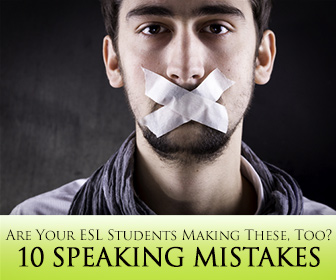Reviewing ESL: 8 Mistakes Your Students Must Overcome Before the Test


Whether they are foreign executives or stay-at-home moms who want to make new friends, speaking mistakes might make them look bad. Let’s take a look at the most common and see how we can help our students move past them towards better fluency.

What I can do to improve my English?
Word order might pose a problem for ESL students in general, but when it comes to questions, the mistake is glaring. This type of mistake when asking questions is often accompanied by the wrong intonation (falling instead of rising, in this case) which makes the question sound like a statement or an incomplete sentence.
There was much people at the party.
It is very easy to tell when a student has not effectively learned the difference between countable and uncountable nouns. They make mistakes with much, many, a little and a few, and less and fewer, giving us phrases like, “I have a few money”, and “I read much books”.
I love Disneyworld. It is very funny.
There are words that ESL students typically mix up; some are quite similar like fun and funny, or farther and further, and there are others that are easily confused like watch, see and look.
My company it is big.
Quite often, ESL students use a noun as the subject of the sentence and yet feel compelled to add the pronoun right after it.
He have a lot of money.
This is a big problem in both speaking and writing. It is very common in ESL learners but a hurdle they should definitely overcome if they want to make a better impression when speaking.
I was born on 1991.
On, at or in? It is one of the most popular questions from students. They use the wrong preposition in so many cases and so often, it is impossible to correct every single one.
My mother told me she broke your leg.
“Your mother broke what?”, screeches the ESL teacher. “I can assure you my leg is not broken.” This is one of my favorite mistakes to correct because this confusion gives rise to all types of funny statements, from students claiming to have spent “your” money to reports of parents having cleaned “your” room.
My daughter is embarrassed and will have her baby next month.
The student’s daughter has nothing to be embarrassed about. The student has made this mistake because the word for pregnant in Spanish is embarazada, and sounds very similar to embarrassed. Each language has words that may sound a lot like words in English but have completely different meanings, and students should be careful with these. Also similar to this mistake is “inventing” words in English by applying typical patterns (involucrated instead of involved from the Spanish involucrado).
Hi! What’s up? (said to a customer)
Even after we get all of the grammatical mistakes out of the way, ESL students still have a hard time figuring out what is appropriate or inappropriate depending on the context.
It’s nice to meet you.
A student may say something that is perfectly correct, grammatically speaking, but what happens if they put the stress on the wrong word? It may lead to confusion or misunderstanding. Consider the difference between, “He didn’t pay for one lesson” vs “He didn’t pay for one lesson”.
There are two tiers to correcting and improving these mistakes. The first tier is the easiest to attack; it is composed of the typical grammatical errors students can work on through extended practice and worksheets. The second tier involves things that students have a hard time grasping, like the difference between informal and more formal language, intonation and stress, as well as the other nuances of the English language.
When it comes to correcting grammar mistakes while students are speaking, every ESL teacher comes to this hard realization: you can’t correct every single mistake. Firstly, it seriously hinders fluency and does not help boost morale if students are being corrected every few seconds or so. Secondly, it simply can’t be done. Not unless you record what a student says and replay it so you can correct every single mistake. As in most things in life, we need to pick our battles, and here’s how you can choose which grammar mistakes to correct:
How can we correct these mistakes in a way that won’t affect overall fluency? Because the student is speaking, and you won’t want to interrupt him or her, the best course of action is to find some way of signaling the mistake. For example, if the same student typically forgets the s in the third person singular, trace an s in the air or flash a card with the letter s when they make this mistake.
How does a student come to understand that it’s ok to say something is very expensive, but not very fabulous? How does a student know when to ask, “What’s up?” and when to ask, “How have you been?” One of the keys is exposure. Exposure to the English language, especially outside the ESL classroom. The more ESL students hear native English speakers using expressions correctly, using sarcasm and colloquial phrases, greeting others and making jokes, the easier it will be for them to grasp these differences and start using them themselves. In addition to exposure, role plays are instrumental in teaching proper intonation, word stress and the use of appropriate expressions. I recommend:
While our job is to correct their mistakes, we must also strive to do so in an encouraging and supportive environment. Instead of focusing on correcting mistakes, let’s help them achieve better fluency.
What types of speaking mistakes do your students struggle with? Share them in the comments below!